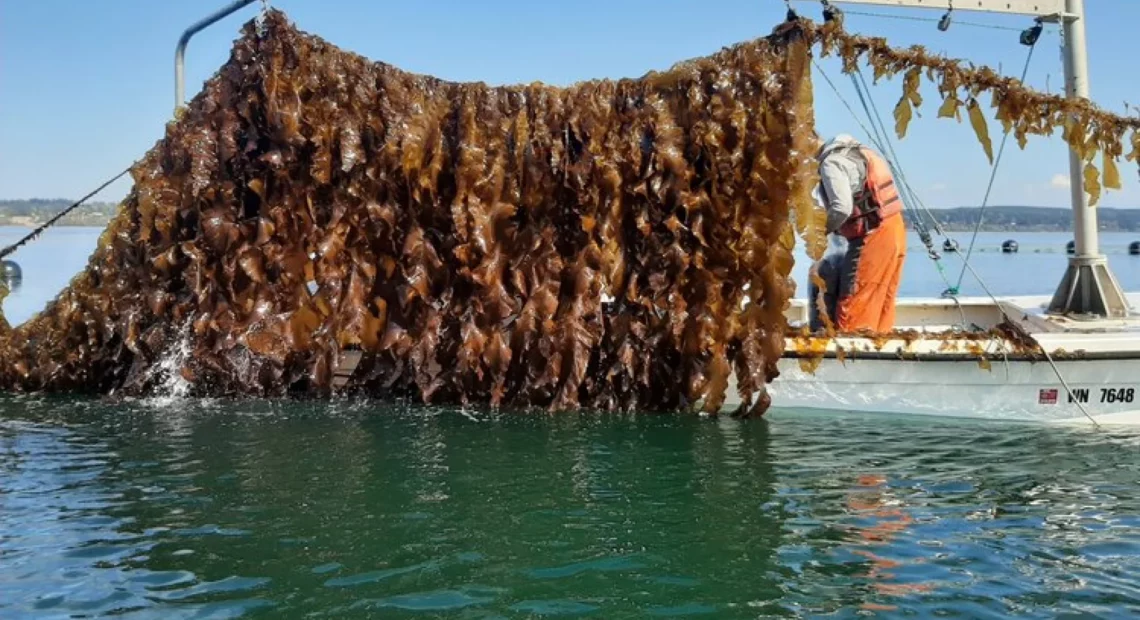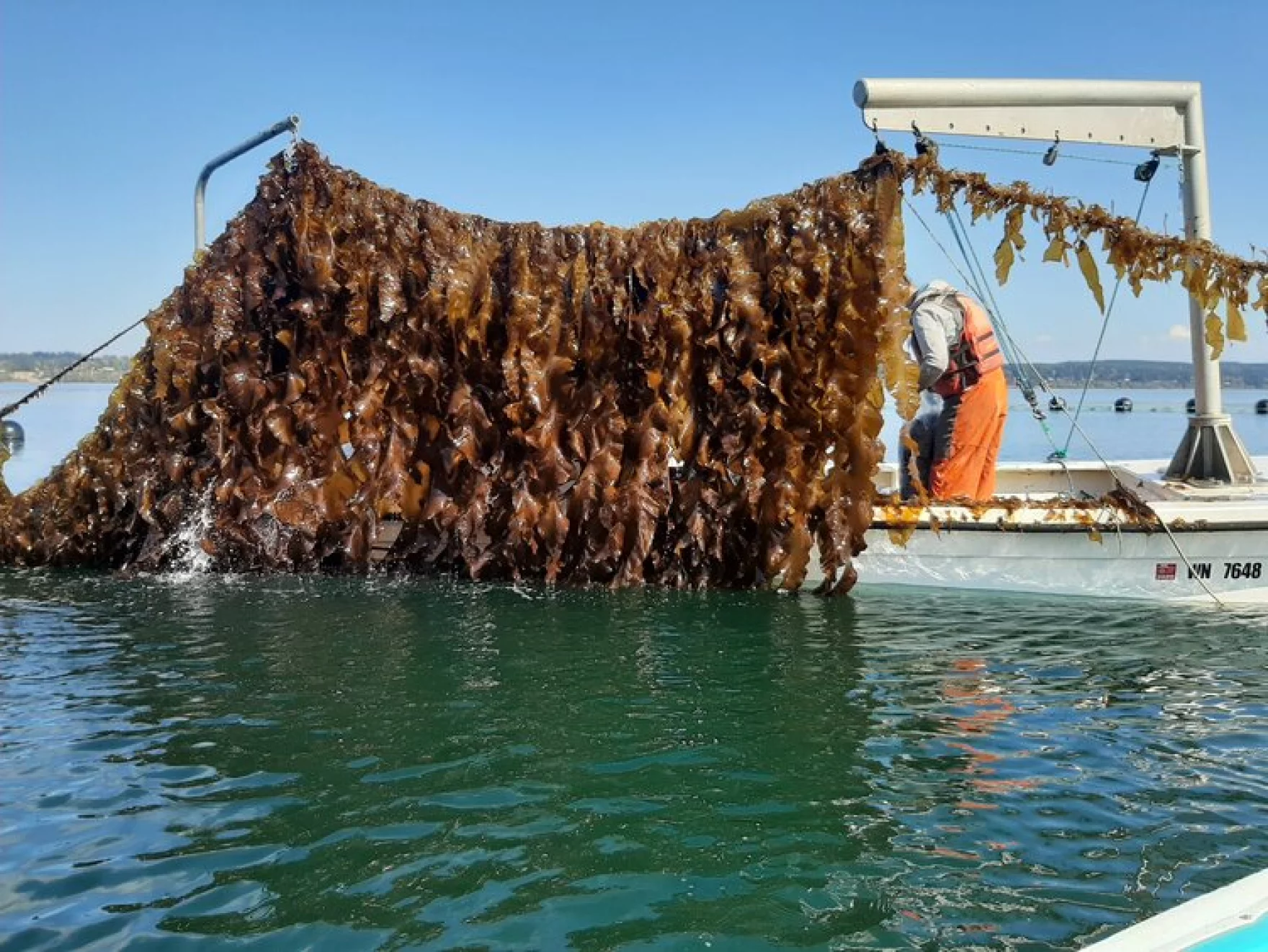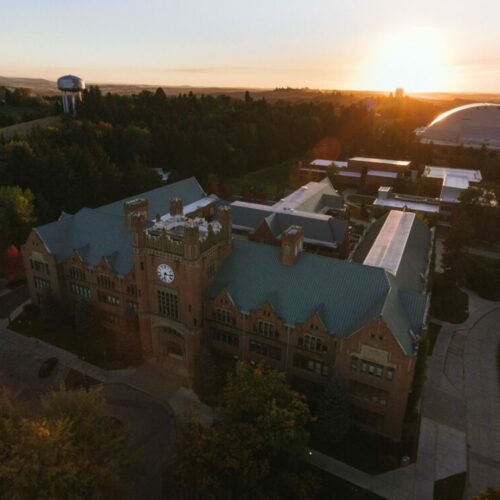
Swelling school of seaweed farmers looking to anchor in somewhat choppy Northwest waters
Read
Prospective kelp growers who want to join the handful of existing commercial seaweed farms in the Pacific Northwest are having to contend with a lengthy permitting process. It’s gotten contentious in a few cases, but even so, at least a couple of new seaweed farms stand on the cusp of approval. Their harvests could be sold for human food, animal feed or fertilizer.
Two permit applications for floating kelp farms near Vashon Island, Washington, generated a flood of public comments to King County regulators. Some islanders strongly objected to what they said would be a risky “eyesore” offshore of their waterfront homes, while supportive commenters touted sustainable food and water quality benefits.
Applicant Mike Kollins wants to set up a 10-acre kelp farm in Colvos Passage to be called Vashon Kelp Forest. A different “Mike,” Mike Spranger, envisions a separate 10-acre kelp and shellfish farm near the southwest corner of the island. Kollins said he is trying to be optimistic while navigating a permitting maze involving more than half a dozen federal, state, tribal and county agencies.
“It’s a new industry, so understandably it takes time to figure out the ins and the outs,” Kollins said in an interview. “But I think it’s going pretty well.”
In October, King County’s Department of Local Services put the Vashon Kelp Forest permit application on hold until Kollins provided answers to nine pages of questions covering all manner of potential environmental, aesthetic and boating impacts.
Island homeowners raised many of those issues in dozens of critical emails submitted to the county during a public comment period. Some suggested siting seaweed aquaculture in front of uninhabited shoreline instead.
“This introduces a visually disturbing, unnatural, rectilinear industrial footprint within the viewshed of a highly visited public natural area and upwards of 50 or more residences that are currently highly taxed, in part, on the basis of their views,” wrote Bob Spencer in his comment.
Sound Action, a small Vashon Island-based environmental group known for appealing permit approvals, raised concerns about both of the proposed kelp farms in its area. The group’s executive director questioned the wisdom of converting healthy marine habitat to commercial aquaculture and mentioned a fear that birds and marine mammals could become entangled.
In response, Kollins commissioned visual renderings that depicted his project as barely noticeable rows of buoys on the water. Kollins is pitching the kelp farm as a restoration project as much as a commercial venture. He explained that growing kelp improves the surrounding water quality and that the sea farm could shed spores to repopulate disappearing wild kelp beds down current.
Meanwhile, a second kelp farm proposed for the south end of Colvos Passage alongside Vashon Island is moving ahead after its co-owner, Mike Spranger, reported he was notified his project just won county approval. A county planner clarified Thursday that the project should not be considered officially approved until an appeals period passes.
Spranger said his Pacific Sea Farms would be a combination kelp and shellfish growing operation suspended from buoys and taut lines across 10 acres of Puget Sound waters.
“From a food consumption point of view, even though for most people around here seaweed is not a staple – it’s not something we think about – but demand is outstripping supply at this point,” Spranger said last week on the sidelines of a seaweed symposium organized by Washington Sea Grant.
Spranger is eager to become the second in-water commercial seaweed farm to launch in Washington state. An existing kelp farm in Hood Canal named Blue Dot Sea Farms has the honor of being first. Spranger has competition for second position from an entrepreneur near the Canadian border. Commercial fisherman Riley Starks of Lummi Island said he is “on the cusp” of winning final approval for a seasonal kelp farm to be floated in Legoe Bay. Starks wants to grow sugar kelp on just one acre for starters to sell for food or farm fertilizer.
At the Sea Grant symposium, a Washington State Department of Natural Resources division manager said his agency has seven pending applications from aquaculture entrepreneurs for aquatic leases, which is the final step to complete before a commercial seaweed farm can begin in Washington waters. Six of the applicants have designs on Puget Sound and one is located in coastal Willapa Bay.
“We are expecting more applications,” DNR’s Brady Scott said.
Several speakers representing Northwest tribes voiced interest in possibly joining the party, reasoning that such initiatives would not only produce nutritious food for people, but “it’s food for the environment,” too.
Squaxin Island Tribe biologist Jeff Dickison said his tribe has been involved in other types of aquaculture for a long time and is considering expanding to seaweed.
“It’s a natural step to proceed into the seaweed environment,” Dickison said during a panel discussion.
Jamestown S’Klallam tribal vice-chair Loni Grinnell-Greninger said her tribe wants to try seaweed aquaculture as well.
“There will be conflict, plan on it,” warned University of Washington Professor Clare Ryan during a subsequent presentation. Ryan was invited to speak because she studied controversies spawned by geoduck aquaculture over the past decade around Puget Sound. One of the Washington Sea Grant conference organizers cautioned though that geoduck farming might provide an imperfect analogy because it involves cultivating giant clams on leased tidelands closer to waterfront homes.
One seaweed company in Oregon and another in Washington avoided a lot of permitting hurdles by setting up tanks on land instead of seeking aquatic leases. Oregon Seaweed pumps saltwater from the nearby ocean to circulate through its large tanks at the ports of Bandon and Garibaldi. This company grows a reddish-brown seaweed called dulse as a food ingredient.
On Washington’s Kitsap Peninsula, SolSea Ltd. started as a hybrid research-commercial seaweed culture operation on the grounds of NOAA’s Manchester Research Station. SolSea’s tanks there now grow dulse and Chondracanthus, a red algae commonly known as Turkish towel. Company owner Diane Boratyn said she harvests ten months out of the year and most recently achieved 28 tons of annual production. SolSea supplies seaweed extracts for use in cosmetics.
















